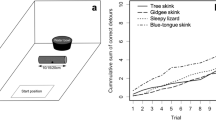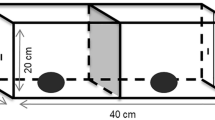Abstract
Despite evidence that organisms are more likely to exhibit their full range of cognitive abilities under conditions found in nature, studies evaluating cognition under such conditions remain rare, particularly in vertebrate species. Here, we conducted an experiment to evaluate problem-solving and motor self-regulation in free-living arboreal lizards, Anolis sagrei, under natural conditions. We presented lizards with a novel detour problem which challenged individuals to circumvent a transparent barrier in order to obtain a food reward. Individuals varied in their ability to solve the detour problem. Furthermore, those that solved the problem were able to improve their performance across trials by modifying the natural response of attempting to strike the reward through the transparent barrier, providing evidence of motor self-regulation. Solving the problem required individuals to modify their typical foraging behavior, as approaching the prey in a single burst of movement that culminated with an attack was an unsuccessful strategy. Contrary to expectations, our findings provide evidence of motor self-regulation in a visually oriented, sit-and-wait predator under natural conditions, suggesting motor self-regulation is not limited by foraging strategy. Our results also underscore the need to evaluate the cognitive abilities of free-living organisms in the wild, particularly for taxa that perform poorly under laboratory conditions.
Significance statement
Studies of animal cognition have a long history in animal behavior, which, in vertebrate species, has been dominated by experiments conducted under controlled laboratory conditions. Here, we showed that experiments can be taken “outside the box,” from the laboratory into natural conditions, and by doing so overcome some of the obstacles that have hindered our ability to study cognition in species unlikely to remain motivated when removed from the wild. We implemented a modified version of the cylinder task, which provided the stimuli needed for a visually oriented, sit-and-wait foraging lizard to participate in the experiments. Individuals of Anolis sagrei learned to solve the task by modifying what was previously described as a stereotyped prey capture behavior. In addition, individuals decreased the number of times they attempted to strike the prey through the transparent barrier. These findings provide further evidence of behavioral flexibility in anoles and new evidence of motor self-regulation. The latter demonstrates the need to extend our current understanding of potential forces favoring the evolution of cognition beyond those that have been proposed in birds and mammals. More generally, our findings demonstrate the importance of using experimental paradigms that are rooted in an understanding of the natural history of the species of interest.


Similar content being viewed by others
Data availability
The datasets generated during and analyzed during the current study are available in the Dryad repository, https://doi.org/10.5061/dryad.g79cnp5mq.
References
Amici F, Aureli F, Call J (2008) Fission-fusion dynamics, behavioral flexibility, and inhibitory control in primates. Curr Biol 18:1415–1419
Anderson RC, Searcy WA, Peters S, Hughes M, DuBois AL, Nowicki S (2017) Song learning and cognitive ability are not consistently related in a songbird. Anim Cogn 20:309–320
Auersperg AMI, von Bayern AMP, Gajdon GK, Huber L, Kacelnik A (2011) Flexibility in problem solving and tool use of kea and New Caledonian crows in a multi access box paradigm. PLoS One 6:e20231
Benson-Amram S, Dantzer B, Stricker G, Swanson EM, Holekamp KE (2016) Brain size predicts problem-solving ability in mammalian carnivores. P Natl Acad Sci USA 113:2532–2537
Benson-Amram S, Holekamp KE (2012) Innovative problem solving by wild spotted hyenas. Proc R Soc Lond B 279:4087–4095
Boogert NJ, Anderson RC, Peters S, Searcy WA, Nowicki S (2011) Song repertoire size in male song sparrows correlates with detour reaching, but not with other cognitive measures. Anim Behav 81:1209–1216
Burghardt GM (2013) Environmental enrichment and cognitive complexity in reptiles and amphibians: concepts, review, and implications for captive populations. Appl Anim Behav Sci 147:286–298
Cauchoix M, Hermer E, Chaine AS, Morand-Ferron J (2017) Cognition in the field: comparison of reversal learning performance in captive and wild passerines. Sci Rep 7:12945
Croston R, Branch CL, Pitera AM, Kozlovsky DY, Bridge ES, Parchman TL, Pravosudov VV (2017) Predictably harsh environment is associated with reduced cognitive flexibility in wild food-caching mountain chickadees. Anim Behav 123:139–149
Davis KM, Burghardt GM (2011) Turtles (Pseudemys nelsoni) learn about visual cues indicating food from experienced turtles. J Comp Psychol 125:404–410
Day LB, Crews D, Wilczynski W (1999) Spatial and reversal learning in congeneric lizards with different foraging strategies. Anim Behav 57:393–407
Diamond A (1990) Developmental time course in human infants and infant monkeys, and the neural bases of, inhibitory control in reaching. Ann N Y Acad Sci 608:637–676
Epstein R, Kirshnit CE, Lanza RP, Rubin LC (1984) ‘Insight’ in the pigeon: antecedents and determinants of an intelligent performance. Nature 308:61–62
Fleishman LJ, Pallus AC (2010) Motion perception and visual signal design in Anolis lizards. Proc R Soc Lond B 277:3547–3554
Griffin AS, Guez D (2014) Innovation and problem solving: a review of common mechanisms. Behav Process 109B:121–134
Healy SD, Hurly TA (2003) Cognitive ecology: foraging in hummingbirds as a model system. Adv Study Behav 32:325–359
Isaksson E, Utku Urhan A, Brodin A (2018) High level of self-control ability in a small passerine bird. Behav Ecol Sociobiol 72:118
Johnson-Ulrich L, Holekamp KE (2020) Group size and social rank predict inhibitory control in spotted hyaenas. Anim Behav 160:157–168
Kabadayi C, Bobrowicz K, Osvath M (2018) The detour paradigm in animal cognition. Anim Cogn 21:21–35
Kabadayi C, Taylor LA, von Bayern AMP, Osvath M (2016) Ravens, New Caledonian crows and jackdaws parallel great apes in motor self-regulation despite smaller brains. R Soc Open Sci 3:160104
Kolbe JJ, Ehrenberger JC, Moniz HA, Angilletta MJ Jr (2014) Physiological variation among invasive populations of the brown anole (Anolis sagrei). Physiol Biochem Zool 87:92–104
Ladage LD, Riggs BJ, Sinervo B, Pravosudov VV (2009) Dorsal cortex volume in male side-blotched lizards (Uta stansburiana) is associated with different space use strategies. Anim Behav 78:91–96
Leal M, Powell BJ (2012) Behavioural flexibility and problem-solving in a tropical lizard. Biol Lett 8:28–30
Lefebvre L, Whittle P, Lascaris E, Finkelstein A (1997) Feeding innovations and forebrain size in birds. Anim Behav 53:549–560
Logan CJ (2016) How far will a behaviourally flexible invasive bird go to innovate? R Soc Open Sci 3:160247
Losos JB (2009) Lizards in an evolutionary tree: ecology and adaptive radiation of anoles. University of California Press, Berkeley
Lucon-Xiccato T, Bisazza A (2017) Individual differences in cognition among teleost fishes. Behav Process 141:184–195
MacLean EL, Hare B, Nunn CL et al (2014) The evolution of self-control. P Natl Acad Sci USA 111:E2140–E2148
Moermond TC (1981) Prey-attack behavior of Anolis Lizards. Z Tierpsychol 56:128–136
Morand-Ferron J, Hamblin S, Cole EF, Aplin LM, Quinn JL (2015) Taking the operant paradigm into the field: associative learning in wild great tits. PLoS One 10:e0133821
Noble DWA, Byrne RW, Whiting MJ (2014) Age-dependent social learning in a lizard. Biol Lett 10:20140430
Noble DWA, Carazo P, Whiting MJ (2012) Learning outdoors: male lizards show flexible spatial learning under semi-natural conditions. Biol Lett 8:946–948
Pinheiro J, Bates D, DebRoy S, Sarkar D, R Core Team (2019) nlme: linear and nonlinear mixed effects models. https://CRAN.R-project.org/package=nlme
Pough FH (1991) Recommendations for the care of amphibians and reptiles. ILAR News 33:S1–S21
Pritchard DJ, Hurly TA, Tello-Ramos MC, Healy SD (2016) Why study cognition in the wild (and how to test it)? J Exp Anal Behav 105:41–55
R Development Core Team (2008) R: a language and environment for statistical computing. R Foundation for Statistical Computing, Vienna. http://www.R-project.org
Santos LR, Ericson BN, Hauser MD (1999) Constraints on problem solving and inhibition: object retrieval in cotton-top tamarins (Saguinus oedipus oedipus). J Comp Psychol 113:186–193
Schiller PH (1949a) Analysis of detour behavior; learning of roundabout pathways in fish. J Comp Physiol Psychol 42:463–475
Schiller PH (1949b) Delayed detour response in the octopus. J Comp Physiol Psychol 42:220–225
Schoener TW, Schoener A (1982) Intraspecific variation in home-range size in some Anolis lizards. Ecology 63:809–823
Scholes NW (1965) Detour learning and development in the domestic chick. J Comp Physiol Psychol 60:114–116
Scholes NW, Wheaton LG (1966) Critical period for detour learning in developing chicks. Life Sci 5:1859–1865
Schwarz S, Mangan M, Zeil J, Webb B, Wystrach A (2017) How ants use vision when homing backward. Curr Biol 27:401–407
Shettleworth SJ (2010) Cognition, evolution, and behavior, 2nd edn. Oxford University Press, New York
Sol D, Duncan RP, Blackburn TM, Cassey P, Lefebvre L (2005) Big brains, enhanced cognition, and response of birds to novel environments. P Natl Acad Sci USA 102:5460–5465
Sol D, Lapiedra O, González-Lagos C (2013) Behavioural adjustments for a life in the city. Anim Behav 85:1101–1112
Sol D, Price TD (2008) Brain size and the diversification of body size in birds. Am Nat 172:170–177
Sol D, Timmermans S, Lefebvre L (2002) Behavioural flexibility and invasion success in birds. Anim Behav 63:495–502
Spigel IM (1964) Learning, retention, and disruption of detour behavior in the turtle. J Comp Physiol Psychol 57:108–112
Stamps JA (1977) The function of the survey posture in Anolis lizards. Copeia 1977:756–758
Steinberg DS, Leal M (2018) Wild vs lab - Cognition outside the box. In: Bueno-Guerra N, Amici F (eds) Field and laboratory methods in animal cognition: a comparative guide. Cambridge University Press, Cambridge, pp 279–285
Szabo B, Noble DWA, Whiting MJ (2019) Context-specific response inhibition and differential impact of a learning bias in a lizard. Anim Cogn 22:317–329
Tebbich S, Sterelny K, Teschke I (2010) The tale of the finch: adaptive radiation and behavioural flexibility. Philos Trans R Soc B 365:1099–1109
Vernouillet A, Anderson J, Clary D, Kelly DM (2016) Inhibition in Clark’s nutcrackers (Nucifraga columbiana): results of a detour-reaching test. Anim Cogn 19:661–665
Vlamings PHJM, Hare B, Call J (2010) Reaching around barriers: the performance of the great apes and 3-5-year-old children. Anim Cogn 13:273–285
von Bayern AMP, Heathcote RJP, Rutz C, Kacelnik A (2009) The role of experience in problem solving and innovative tool use in crows. Curr Biol 19:1965–1968
Wickham H (2009) ggplot2: Elegant graphics for data analysis. Springer-Verlag, New York
Wilkinson A, Kuenstner K, Mueller J, Huber L (2010) Social learning in a non-social reptile (Geochelone carbonaria). Biol Lett 6:614–616
Wright TF, Eberhard JR, Hobson EA, Avery ML, Russello MA (2010) Behavioral flexibility and species invasions: the adaptive flexibility hypothesis. Ethol Ecol Evol 22:393–404
Wynne CDL, Leguet B (2004) Detour behavior in the Quokka (Setonix brachyurus). Behav Process 67:281–286
Acknowledgments
We thank J. Jones and W. McHargue for assistance in the field; the members of the Chipojo lab, D. Steinberg, R. Cocroft, G. Burghardt; and two anonymous reviewers for helpful comments that greatly improved this manuscript; the National Science Foundation (DEB-0949357 and IOS-1051793); and the Bahamas Ministry of Agriculture and the Bahamas Environment, Science, and Technology Commission of the Ministry of the Environment for permission to conduct this research.
Ethics approval
This research adhered to the guidelines of the Institutional Animal Care and Use Committee at University of Missouri, Columbia protocol (#8244). We followed the Recommendations for the Care of Amphibians and Reptiles (Pough 1991) in the treatment of all animals used in this study. This is a field study, and as part of this study, animals were only individually marked and immediately released. The Bahamas Ministry of Agriculture and the Bahamas Environment, Science, and Technology Commission of the Ministry of the Environment provided permission to conduct this research.
Funding
This work was partially funded by the National Science Foundation (DEB-0949357 and IOS-1051793 to ML).
Author information
Authors and Affiliations
Contributions
LS carried out the experiment, participated in data analysis, participated in the design of the study, and helped in drafting the manuscript; ML conceived of the study, helped with the data analysis, and drafted the manuscript. All authors gave final approval for publication.
Corresponding author
Ethics declarations
Conflict of interest
The authors declare that they have no conflict of interests.
Additional information
Communicated by T. Madsen
Publisher’s note
Springer Nature remains neutral with regard to jurisdictional claims in published maps and institutional affiliations.
Rights and permissions
About this article
Cite this article
Storks, L., Leal, M. Thinking outside the box: problem-solving in free-living lizards. Behav Ecol Sociobiol 74, 75 (2020). https://doi.org/10.1007/s00265-020-02852-x
Received:
Revised:
Accepted:
Published:
DOI: https://doi.org/10.1007/s00265-020-02852-x




